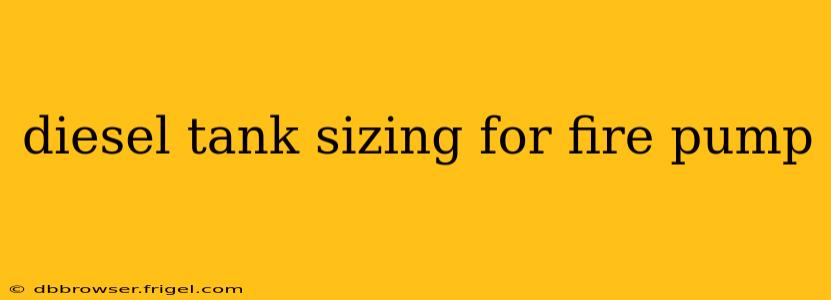Designing a fire protection system requires careful consideration of all components, and the diesel tank for your fire pump is no exception. Proper sizing ensures sufficient fuel supply during emergencies, preventing system failure when it's needed most. This guide explores the crucial factors influencing diesel tank sizing for fire pumps, helping you make informed decisions for optimal fire safety.
What Factors Determine Diesel Tank Size for a Fire Pump?
Several key factors influence the necessary size of a diesel fuel tank for your fire pump:
-
Pump Capacity and Run Time: The most critical factor is the fire pump's capacity (gallons per minute or liters per minute) and the anticipated runtime during a fire event. A larger pump requiring longer operation naturally demands a larger fuel tank. Fire codes and insurance requirements often dictate minimum runtime expectations.
-
Fuel Consumption Rate: Knowing your pump's specific fuel consumption rate (gallons per hour or liters per hour) at its rated capacity is essential. This information is typically found in the pump's technical specifications or manufacturer documentation.
-
Redundancy and Reserve Capacity: Building in redundancy is crucial. It's best practice to have sufficient fuel to operate the pump beyond the anticipated maximum fire duration. This accounts for unexpected delays in refueling or extended fire events. A common practice is to include a significant reserve capacity, often 50% or more of the estimated consumption, for added safety.
-
Local Codes and Regulations: Always check local fire codes and building regulations. These codes often specify minimum tank sizes based on the building's occupancy type, fire risk classification, and the size of the fire pump. Non-compliance can lead to significant penalties and insurance issues.
-
Accessibility and Location: The tank's location and accessibility for refueling should be considered. A readily accessible location simplifies refueling during an emergency, while considerations of environmental protection must also be addressed.
-
Tank Type and Material: Various tank types exist, each with its advantages and disadvantages regarding cost, durability, and environmental impact. The choice of material affects the tank's lifespan and potential for corrosion.
How to Calculate Diesel Tank Size for a Fire Pump?
Calculating the required tank size involves several steps:
-
Determine the pump's fuel consumption rate: Consult the pump's specifications or manufacturer's data to find its fuel consumption rate in gallons per hour (GPH) or liters per hour (LPH) at its rated capacity.
-
Estimate the required runtime: This is determined based on factors like the building's size, occupancy, and local fire codes. It's crucial to consult with fire protection engineers to ensure accurate estimations.
-
Calculate the total fuel needed: Multiply the fuel consumption rate by the estimated runtime to obtain the total fuel needed in gallons or liters.
-
Add redundancy and reserve capacity: Add a safety margin of at least 50% to the total fuel needed to account for unexpected situations.
-
Select an appropriate tank size: Choose a tank with a capacity equal to or greater than the calculated total fuel requirement, including the reserve.
What are the Different Types of Diesel Tanks for Fire Pumps?
Several tank types are suitable for fire pumps, each with specific advantages and disadvantages:
-
Aboveground Tanks: These are readily accessible for inspection and refueling but can be subject to vandalism or damage.
-
Underground Tanks: They offer better protection from the elements and potential damage but require more extensive installation and maintenance.
-
Double-Walled Tanks: These tanks provide secondary containment, minimizing the risk of environmental contamination in case of leakage.
-
Steel Tanks: Durable and relatively inexpensive, but prone to corrosion.
-
Fiberglass Tanks: Resistant to corrosion and lighter than steel tanks, but can be more expensive.
What are the Safety Considerations for Diesel Tanks?
-
Proper Ventilation: Adequate ventilation around the tank is essential to prevent the build-up of flammable vapors.
-
Spill Containment: Measures to contain potential spills must be in place.
-
Lightning Protection: Grounding and lightning protection are crucial to prevent fires caused by lightning strikes.
-
Regular Inspection and Maintenance: Regular inspection and maintenance of the tank and its associated equipment are essential for ensuring its longevity and safety.
How Often Should I Inspect My Diesel Tank?
The frequency of inspection depends on local regulations and the tank's type and condition. Regular visual inspections should be performed at least monthly, checking for leaks, corrosion, or damage. More frequent checks might be required depending on factors like the tank's age, material, and environmental conditions.
This comprehensive guide provides a solid foundation for understanding diesel tank sizing for fire pumps. Remember to always consult with qualified professionals like fire protection engineers to ensure compliance with all relevant codes and regulations and to guarantee the optimal design and safety of your fire protection system.
